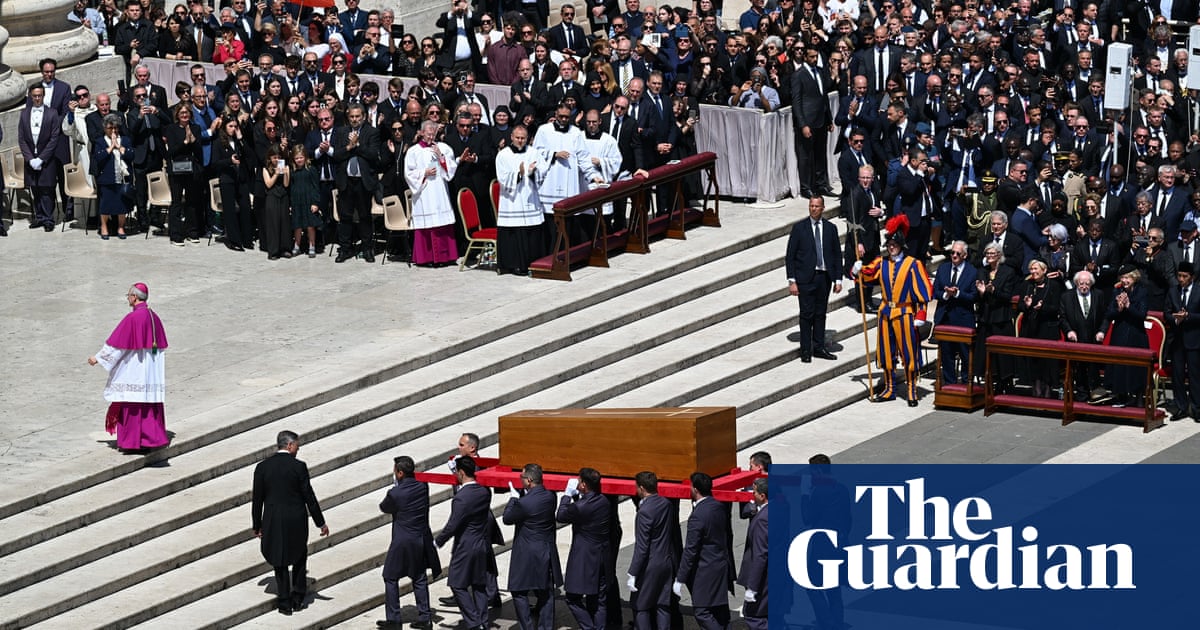Pope Francis has been eulogised as “a pope among the people, with an open heart towards everyone” during a funeral mass that brought together an array of mourners, from pilgrims and refugees to powerful world leaders and royals.
Francis, 88, died on Mondayafter a stroke and subsequent heart failure, setting into motion a series of centuries-old rituals and a huge, meticulously-planned logistical and security operation not seen in Italy since the funeral of John Paul II in April 2005.
The crowd erupted into applause as the late pontiff’s wooden coffin was carried from the altar of the 16th-century St Peter’s Basilica, where it had laid in state for three days, by 14 white-gloved pallbearers and into the square for the open-air ceremony.
Applause also rang out when the Italian cardinal Giovanni Battista Re, who presided over the funeral mass, spoke of Francis’s care for immigrants, his constant pleas for peace, the need for negotiations to end wars and the importance of the climate.
Under a blue sky, more than 250,000 pilgrims descended on theVatican, with the crowds stretching along Via della Conciliazione, the road connecting the Italian capital with the Vatican.
Among the pilgrims were Rosa Cirielli and her friend Pina Sanarico, who left their homes in Taranto, in southernItaly, at 5am, and managed to secure themselves a decent position in front of a huge TV screen. “When Pope Francis was alive, he gave us hope. Now we have this huge hole,” said Cirielli. “He left us during a very ugly period for the world. He was the only one who loudly called for peace.”
The pilgrims were joined by leaders from more than 150 countries, including the US president, Donald Trump, who had repeatedly clashed with Francis over immigration, and his wife Melania. A White House official said Trump had a “very productive” meeting before the ceremony with Ukrainian president, Volodymyr Zelenskyy. A photo showed the pair sitting opposite each other on chairs inside St Peter’s Basilica. Another image showed them together with the British prime minister, Keir Starmer, and French president, Emmanuel Macron. Trump and Zelenskyy were also expected to meet after the mass.
Other guests included the former US president Joe Biden, who last met Francis at the G7 summit in Puglia last June, the Argentinian president, Javier Milei, the European commission president, Ursula von der Leyen, and Prince William.
More than 2,000 journalists from around the world travelled to Rome to cover the event.
The 90-minute mass was celebrated by 220 cardinals, 750 bishops and more than 4,000 priests.
“The outpouring of affection that we have witnessed in recent days following his passing from this Earth into eternity tells us how much the profound pontificate of Pope Francis touched minds and hearts,” Battista Re said at the start of his eulogy.
He recalled that the last image many people would have had of Francis was of him delivering what would become his final blessing on Easter Sunday, and saluting from the popemobile in the same piazza where his funeral was celebrated.
Di Battista described Francis’s charisma of “welcome and listening”, adding that the guiding thread of his mission was “the conviction that the church is home for all”.
There was more applause and cries of “Papa Francesco!” among the crowds lining the streets as the late pontiff made his final journey, aboard a specially adapted popemobile, from the Vatican towards his burial tomb at Santa Maria Maggiore Basilica in Rome’s Esquilino neighbourhood.
Flanked by police on motorbikes, the vehicle, which had been used on one of Francis’s trips overseas, crossed a bridge over Rome’s Tiber River, before slowly making its way along Via Vittorio Emmanuel, passing Piazza Venezia, the Roman Forum, and the Colosseum before arriving at Santa Maria Maggiore, a basilica loved by Francis.
Francis was given a final sendoff by a group of 40 people, including prisoners, refugees, transgender people and the homeless, who awaited his arrival on the steps of the fourth-century basilica.
Francis is the first pontiff in more than a centurynot to be buried with great fanfarein the grottoes beneath St Peter’s Basilica.
Instead, his coffin will be entombed in a small niche that until now has been used to store candlestick holders.
As requested in his final testament, the tomb will not be decorated and will be inscribed only with his papal name in Latin: Franciscus. The burial will be a private event attended by Francis’s relatives. The public will be able to visit the tomb from Sunday.
As the funeral wraps up, speculation about who will succeed Francis will go into overdrive.
Francis, born in Argentina, was the first non-European pope for almost 13 centuries. During his 12-year papacy, the liberal late pontiff faced some fierce challenges from rightwing cardinals. Nine days of mourning will begin from Saturday, with a conclave – thesecret election process to choose a new pope– therefore not expected to begin before 5 May.
There is no clear frontrunner, although Luis Antonio Tagle, a reformer from the Philippines, and Pietro Parolin, from Italy, are early favourites.
Virginio and his wife Anna Maria travelled to Rome from Naples for the funeral. They’re here to reflect on Francis but are also contemplating who will follow him.
“We hope the new pope continues along the same line as Francis,” said Anna Maria.
